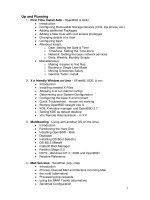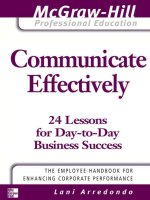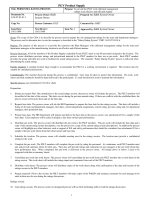Tài liệu Core Competencies pdf
Bạn đang xem bản rút gọn của tài liệu. Xem và tải ngay bản đầy đủ của tài liệu tại đây (148.79 KB, 13 trang )
Core Competencies
Core Skill Bundles for HR in the New World
The term "core competency" first became popular through an article on the subject which
appeared in Harvard Business Review in June 1990, entitled The Core Competency of the
Corporation, by Pralahad and Hamel. It defined core competencies as "the collective
learnings in the organization, especially how to coordinate diverse production skills and
integrate multiple streams of technologies." The thesis being that core competencies (i.e.,
harmonizing streams of technology) can become a way of competing via developing new
products built around/off of a firm's proven competencies. Examples are the logistics
system of Federal Express or Honda's engine technology or dealer network; competencies
which are hard for the competition to copy.
When we discuss this in terms of functions in a company, it centers on the question of how
does a function link its know-how to support the company's core competencies to improve
operating results. For Human Resources it comes down to identification and "bundling" of
key skill areas for deployment into business units, and creating the mechanism to keep
these fresh and relevant to individuals and the organization.
For the organization, year 0-2005 and beyond, Human Resources professionals must
develop deep skills and expertise in five areas to ensure that value is added. Value is
defined as increasing capability, eliminating barriers to speed, and/or increasing focus or
alignment for example. While all five are equally important, not all five are delivered in the
same way; four are deployed to build individual and organizational capacity via resources
with leaders and their teams in line business units and one is a bundle of work processes
which supports the entire corporation. Said another way, HR is organized around two
platforms, one of which is delivered by professionals working in the line business, while the
other is delivered in support of those working in line units by off-line resources.
For more
detail on the Competencies and the Role of HR,
clickhere.
The Core Competencies of Human Resources are:
• Understanding of Our Business
• Driving Change and Managing Transformation
• The Ability to Create and Manage Culture
• Management of HR Practices/Deliver HR
• Personal Credibility and Influence
Understanding of Our Business
HR People must Understand the Business. In order to develop and resource
business leaders, their teams, and the organizations they lead, HR practitioners
must fully understand the business. This means all aspects of the business;
strategies, objectives, measures, competitors, customers, and how all functions
contribute. This takes development and experience. One can't give advice, make
recommendations or contribute with competence and credibility without this
knowledge and experience. Hence, the importance of business assignments in the
line before assuming the HR role is critical. One learns the business by working in
the business and develops the external focus and the skills to help leaders
develop sustainable competitive advantage through these assignments.
Understanding of our business involves skills in the following areas:
Strategies
Refers to the choices a business makes to organize around to best position us to "win" with
consumers versusour competitors.
Metrics
The measures chosen to evaluate progress on strategies. Always numbers, and most often
shown as a "gap" between two numbers.
Core Skills Assessment
Print this page and circle all areas below where you have demonstrated successful
results in using the core skills listed. You may circle items in different skill levels.
The skills listed below are stratified to help determine the actual level of
experience a person has so plans can be developed to gain more
experience/proficiency.
Basic
· Basic understanding of the Business Process
· Knowledge of strategies, metrics, customers, competitors and cross-functional
contributions
· Understands and can make assessment of how HR Core Skills "fit" with delivery of the
CEO/Business Leaders' agenda.
· Can analyze the status/state of the business and see/explain areas of opportunity.
· Able to lead discussions about the business.
Advanced
· Solid understanding of the business, the key consumers and the positioning and "state" of
the competitive set.
· Called upon to make suggestions for interventions to improve results based on analysis of
the business.
· Able to evaluate the cause and effect of our interventions and anticipatively offer counter
measures to improve results.
· Takes the lead in partnering with BU LT to educate/train the organization on our strategies
and interventions.
Master
· Called upon to solve strategic business problems and suggest interventions to improve
results.
· Make effective recommendations on how to make changes in linking culture with strategy
to improve results.
· Capable of leading the BULT in the analysis of results and guiding them to clear, focused
action plans.
· Used as the Master developer of those training to lead the HR role in the business.
CLICK HERE to open the assessment file that lists all core skills on one page
Customers
The individuals or organizations that services are provided for.
Competition
Other companies in our business we vie with to gain volume and market share. HR
professionals must bring their skills and business competencies to bear so that competitive
advantage is achieved.
Functional Excellence/ Contribution
The unique skills/knowledge that functions add to the business
PS = Manufacturing, Engineering, Purchasing
R&D = Science and Technology
HR = Improving the capability of individuals and organizations
The CEO's Agenda
The direction, focus and priorities of the top leadership of the company.....and working to
understand how things fit together (the contributions you and your organization make) to
achieve it.
Human Resources 2005
Core Skills/Competencies Assessment Form
HR Core Skills:
Circle all areas below where you have demonstrated successful results in using the core skills listed. You may circle items in different skill levels. The
skills listed below are stratified to help determine the actual level of experience a person has so plans can be developed to gain more
experience/proficiency.
Key Activity/
Core Skill
Basic Advanced Master
1.
Underst
anding of
Our
Business
Basic understanding of the Business
Process
Knowledge of strategies, metrics,
customers, competitors and cross-
functional contributions
Understands and can make
assessment of how HR Core Skills
“fit” with delivery of the
CEO/Business Leaders’ agenda.
Can analyze the status/state of the
business and see/explain areas of
opportunity.
Able to lead discussions about the
business.
Solid understanding of the
business, the key consumers and
the positioning and “state” of the
competitive set.
Called upon to make suggestions
for interventions to improve
results based on analysis of the
business.
Able to evaluate the cause and
effect of our interventions and
anticipatively offer counter
measures to improve results.
Takes the lead in partnering with
BU LT to educate/train the
organization on our strategies
and interventions.
Called upon to solve strategic
business problems and suggest
interventions to improve
results.
Make effective
recommendations on how to
make changes in linking
culture with strategy to
improve results.
Capable of leading the BULT in
the analysis of results and
guiding them to clear, focused
action plans.
Used as the Master developer
of those training to lead the
HR role in the business.
2. Driving
Change and
Managing
Transfor-
mation
Understands models and tools and
can apply them to basic situations
in the business.
Understands and can train others in
the theory of change and the
change process, and how they
apply to improve operating results.
Capable of developing success
measures for business change
efforts, and on how to evaluate
progress/modify plans to achieve
results.
Can lead discussions on how
change plans are built around PVP
to ensure constancy of purpose and
continuity.
Able to build good/effective working
relationships as the lever for
change, and understands the
fundamentals of managing conflict
and differences to drive progress.
Clear on the leadership role in
change and on techniques for
coaching/developing leaders.
Can lead the change process and
select the models and tools
appropriate to achieve successful
results in the business.
Sought out by BULT and others as
a resource and developer of
others in change management.
Creates comprehensive change
efforts with clear measures and
can rapidly develop counter
measures/plans as issues arise
requiring course correction.
Models the behaviors of PVP in
interactions and in leading the
process.
Recognized as a builder of solid
relationships with leaders and
those impacted by change to
ensure successful outcomes.
Has successfully developed of
leaders for change efforts.
Sought out as the
“sage”/advisor on complex
change processes. Has deep
command of all change
models/tools and successful
experiences from using them.
Key resource and advisor to
top managers in the company.
May also be recognized outside
of P&G.
“Change Master” status has led
to being the
resource/developer of leaders
and in leading the
development of aspiring
change agents.
Has led change successfully at
almost every level in the
organization and in most every
type of organization.
3. Ability to
Create and
Manage
Culture
Understands the concepts of culture
and strategy as two critical
components for successful business
improvement.
Has worked on projects to assess
and define culture and practiced the
mechanics of designing a culture to
“fit”/support delivery of business
strategies.
Has worked to define the sub-
system/sub-processes of the
culture which drive change with
some success (rewards,
communications, leadership
development, linking customers,
performance management, etc.)
and can do the gap analysis and
make recommendations for cultural
development.
Can define the cultural
linkages/levers which support
business improvement and define
the steps for making change.
Called on to lead the design and
change of culture in support of
business improvements.
Capable “troubleshooter” to
identify the “fixes” needed to
realign/mobilize the change effort
if it stalls.
Experienced in line and staff
designs to improve alignment and
operating results.
Experienced in the complexity of
cross-functional/cross-unit/global
design issues and has had
success in these designs.
Capable of coaching and
developing leadership
competence.
The master of cultural design
and development sought out
by business leaders to assist in
the most complex change
efforts.
The master sought out by
practitioners to coach/resource
them on their efforts.
Mentor of people who are
learning the concepts and
technology – master teacher.
Veteran of many complex
change efforts – often
recognized outside of P&G.









